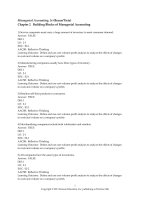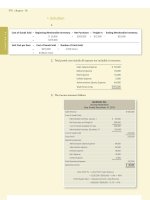Financial managerial accounting 3rd kieso ch17(activity based costing)
Bạn đang xem bản rút gọn của tài liệu. Xem và tải ngay bản đầy đủ của tài liệu tại đây (1.96 MB, 49 trang )
Financial &
Managerial
Accounting
3rd Edition
Jerry Weygandt, Paul
Kimmel, Don Kieso
Prepared by
Coby Harmon
University of California, Santa
Barbara
Westmont College
17-1
CHAPTER 17
Activity-Based Costing
Chapter Outline
LEARNING OBJECTIVES
LO 1 Discuss the difference between traditional costing and
activity-based costing.
LO 2 Apply activity-based costing to a manufacturer.
LO 3 Explain the benefits and limitations of activity-based
costing.
LO 4 Apply activity-based costing to service industries.
17-2
Traditional vs. Activity-Based Costing
LEARNING OBJECTIVE 1
Discuss the difference between traditional costing and activity-based costing.
Traditional Costing Systems
Allocates overhead using a predetermined rate.
►
Job order costing: direct labor cost may be the
relevant activity base.
►
Process costing: machine hours may be the
relevant activity base.
17-3
LO 1
Illustration of a Traditional Costing System
Atlas Company produces two abdominal fitness products—the Ab
Bench and the Ab Coaster. Direct materials cost per unit is $40 for
the Ab Bench and $30 for the Ab Coaster. Direct labor cost is $12
per unit for each product. Both products require one direct labor
hour per unit, are allocated overhead cost of $30 per unit.
ILLUSTRATION 17.3
Total unit costs—
traditional costing
17-4
LO 1
The Need for a New Approach
17-5
Tremendous change in manufacturing and service
industries.
Decrease in amount of direct labor usage.
Significant increase in total overhead costs.
Inappropriate to use plantwide predetermined overhead
rates when a lack of correlation exists.
Complex manufacturing processes may require
multiple allocation bases (Activity-Based Costing).
LO 1
Activity-Based Costing
An approach for allocating overhead costs.
Allocates overhead to multiple activity cost pools.
Assigns the activity cost pools to products or services by
means of cost drivers.
Key Concepts
Activity. Any event, action, transaction, or work sequence that
incurs costs when producing a product or performing a service.
Activity cost pool. Overhead cost attributed to a distinct activity
(e.g., ordering materials or setting up machines).
Cost driver. Any factor or activity that has a direct cause-effect
relationship with the resources consumed.
17-6
LO 1
Activity-Based Costing (Four Steps)
1. Identify and classify the activities involved in the
manufacture of specific products and assign overhead to
cost pools.
2. Identify the cost driver that has a strong correlation to the
costs accumulated in each cost pool.
3. Compute the activity-based overhead rate for each cost
pool.
4. Allocate overhead costs to products using the overhead
rates determined for each cost pool.
17-7
LO 1
Activity-Based Costing
ABC allocates overhead in a two-stage process:
Stage 1: Overhead costs are assigned to activity cost
pools (Step 1).
Stage 2: Allocates overhead assigned to the activity
cost pools to products, using cost drivers (Steps 2-4).
The more complex a product’s manufacturing operation,
the more activities and cost drivers are likely to be present.
17-8
LO 1
ILLUSTRATION 17.5
Activities and related
cost drivers
Illustration 17-2
Activities and related cost drivers
17-9
ILLUSTRATION 17.5
Activities and related
cost drivers
Illustration 17-2
Activities and related cost drivers
17-10
LO 1
DO IT! 1
Costing Systems
Indicate whether the following statements are true or false.
1. A traditional costing system allocates overhead by means of
multiple overhead rates.
2. Direct material and direct labor costs are easier to trace to
products than overhead.
3. As manufacturing processes have become more automated,
more companies have chosen to allocate overhead on the basis
of direct labor costs.
4. In activity-based costing, an activity is any event, action,
transaction, or work sequence that incurs cost when producing
a product.
Solution: 1. False.
17-11
2. True.
3. False.
4. True.
LO 1
ABC and Manufactures
LEARNING OBJECTIVE 2
Discuss the difference between traditional costing and activity-based costing.
Involves the following four steps.
1. Identify and classify activities involved in the manufacture
of specific products and assign overhead to cost pools.
2. Identify the cost driver that has a strong correlation to the
costs accumulated in each cost pool.
3. Compute the activity-based overhead rate for each cost
pool.
4. Allocate overhead costs to products, using overhead rates
determined for each cost pool.
17-12
LO 2
Identify and Classify Activities and Allocate
Overhead to Cost Pools (Step 1)
Overhead costs are assigned directly to the appropriate activity
cost pool.
ILLUSTRATION 17.6
Activity cost pools and
estimated overhead
17-13
LO 2
Identify Cost Drivers (Step 2)
Cost driver must accurately measure the actual consumption
of the activity by the various products.
ILLUSTRATION 17.7: Cost drivers that Atlas Company
identifies and their total expected use per activity cost pool.
ILLUSTRATION 17.7
Activity Cost Pools
Cost Drivers
Estimated Use
of Cost Drivers
per Activity
Manufacturing
hours
Machine hours
50,000 machine
Setups
Number of setups
2,000 setups
Purchase ordering
orders
Number of purchase orders
Product development
developed
Products developed
17-14
2,500 purchase
2 products
LO 2
Compute Activity-Based Overhead
Rates (Step 3)
Next, the company computes an activity-based overhead
rate per cost driver.
ILLUSTRATION 17.8
ILLUSTRATION 17.9
17-15
LO 2
Allocate Overhead Costs to Products (Step 4)
In allocating overhead costs, it is necessary to know the
expected use of cost drivers for each product. Because of its
low volume and higher number of components, the Ab Coaster
requires more setups and purchase orders than the Ab Bench.
Illustration 17-8
ILLUSTRATION 17.10
Expected use of cost drivers per product
17-16
LO 2
Allocate Overhead Costs to Products (Step 4)
To allocate overhead costs, Atlas multiplies the activity-based
overhead rates per cost driver (Ill. 17-9) by the number of cost
drivers expected to be used per product (Ill. 17-10).
ILLUSTRATION 17.11
Allocation of activity
cost pools
to products
17-17
LO 2
Allocate Overhead Costs to Products (Step 4)
To allocate overhead costs, Atlas multiplies the activity-based
overhead rates per cost driver (Ill. 17-9) by the number of cost
drivers expected to be used per product (Ill. 17-10).
ILLUSTRATION 17.11
17-18
LO 2
Comparing Unit Costs
ILLUSTRATION 17.12
Comparison of unit product costs
Illustration 17-10
Likely consequence of differences in assigning overhead.
17-19
Overpricing the Ab Bench and possibly losing market
share to competitors.
Sacrificing profitability by underpricing the Ab Coaster.
LO 2
DO IT! 2
Apply ABC to Manufacturer
Casey Company has five activity cost pools and two products. It
expects to produce 200,000 units of its automobile scissors jack and
80,000 units of its truck hydraulic jack. Having identified its activity
cost pools and the cost drivers for each cost pool, Casey Company
accumulated the following data relative to those activity cost pools
and cost drivers.
17-20
LO 2
DO IT! 2
Apply ABC to Manufacturer
Casey Company has five activity cost pools and two products. It
expects to produce 200,000 units of its automobile scissors jack and
80,000 units of its truck hydraulic jack. Having identified its activity
cost pools and the cost drivers for each cost pool, Casey Company
accumulated the following data relative to those activity cost pools
and cost drivers.
Using the data provided,
a. Prepare a schedule showing the computations of the activitybased overhead rates per cost driver.
b. Prepare a schedule assigning each activity’s overhead cost to
the two products.
c. Compute the overhead cost per unit for each product.
d. Comment on the comparative overhead cost per unit.
17-21
LO 2
DO IT! 2
Apply ABC to Manufacturer
a. Prepare a schedule showing the computations of the activitybased overhead rates per cost driver.
17-22
LO 2
DO IT! 2
17-23
b. Prepare a schedule assigning each
activity’s overhead cost to the two
products.
LO 2
DO IT! 2
Apply ABC to Manufacturer
c. Compute the overhead cost per unit for each product.
d. Comment on the comparative overhead cost per unit.
These data show that the total overhead assigned to 80,000
hydraulic jacks exceeds the overhead assigned to 200,000
scissors jacks. The overhead cost per hydraulic jack is $34.25.
It is only $12.80 per scissors jack.
17-24
LO 2
ABC Benefits and Limitations
LEARNING OBJECTIVE 3
Explain the benefits and limitations of activity-based costing.
ABC has three primary benefits:
1. More cost pools, therefore more accurate product costing.
2. Enhanced control over overhead costs.
3. Better management decisions.
17-25
LO 3









